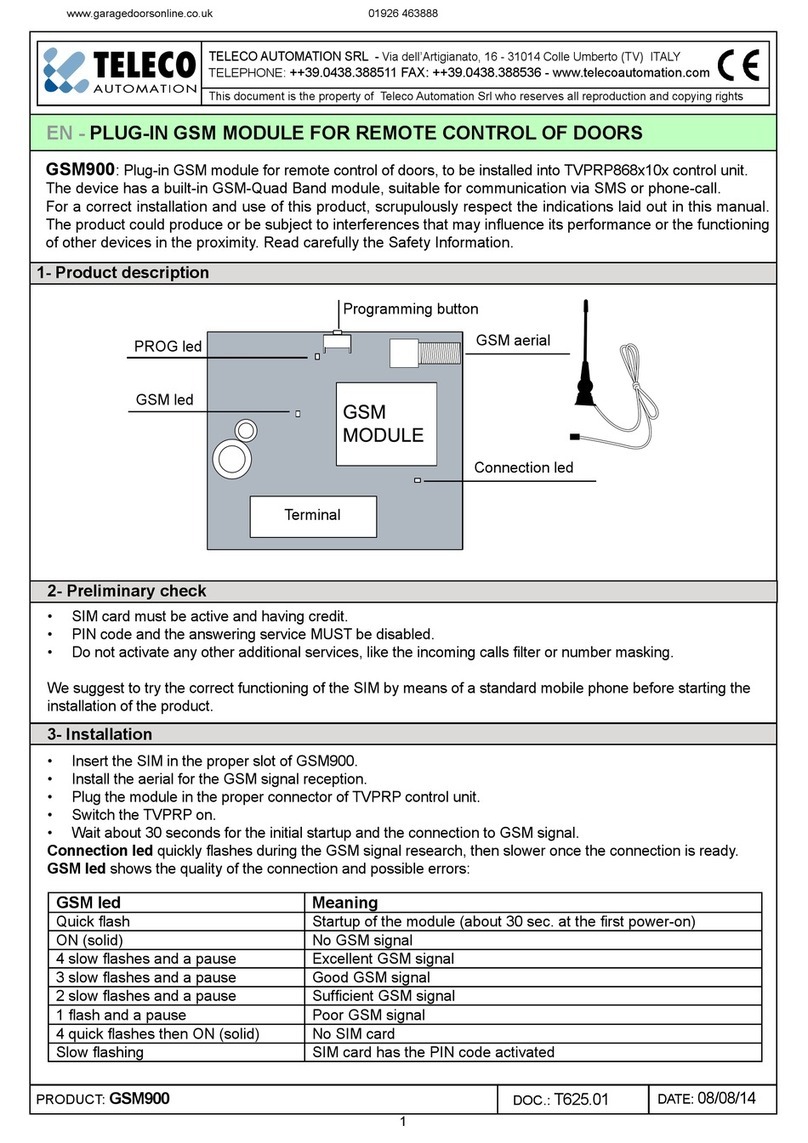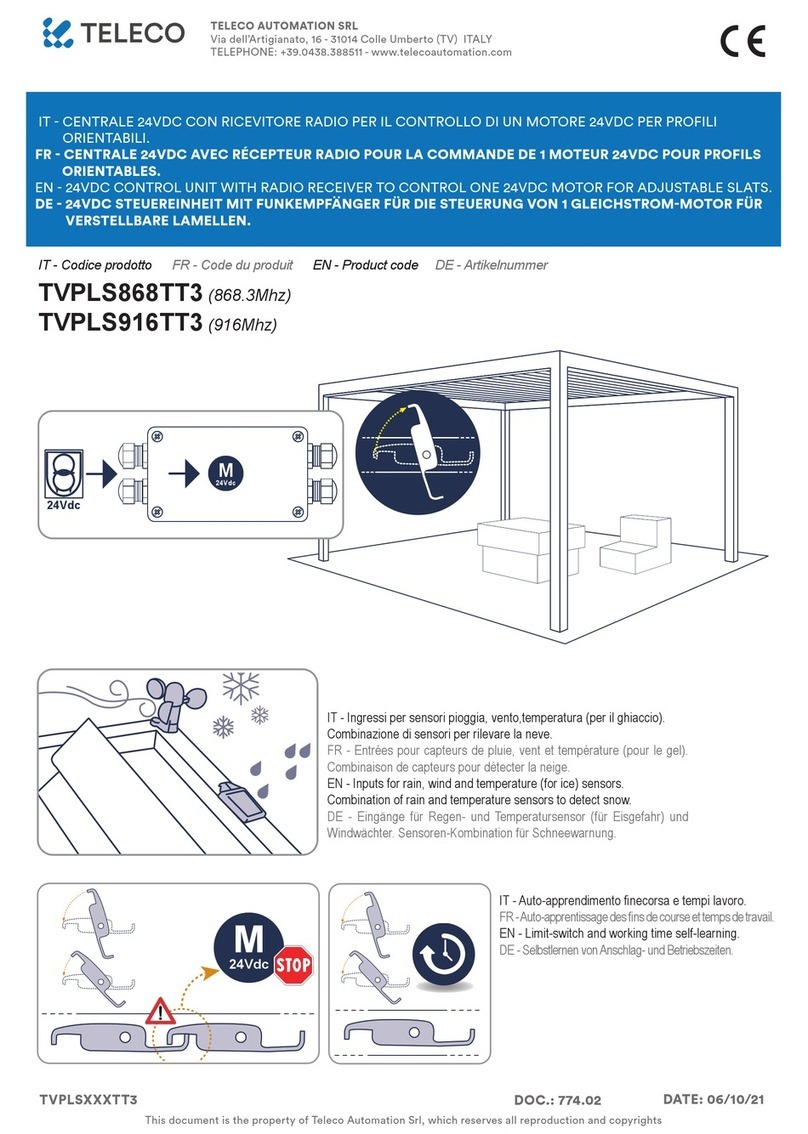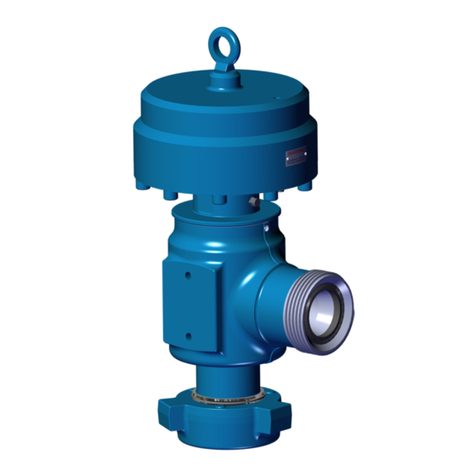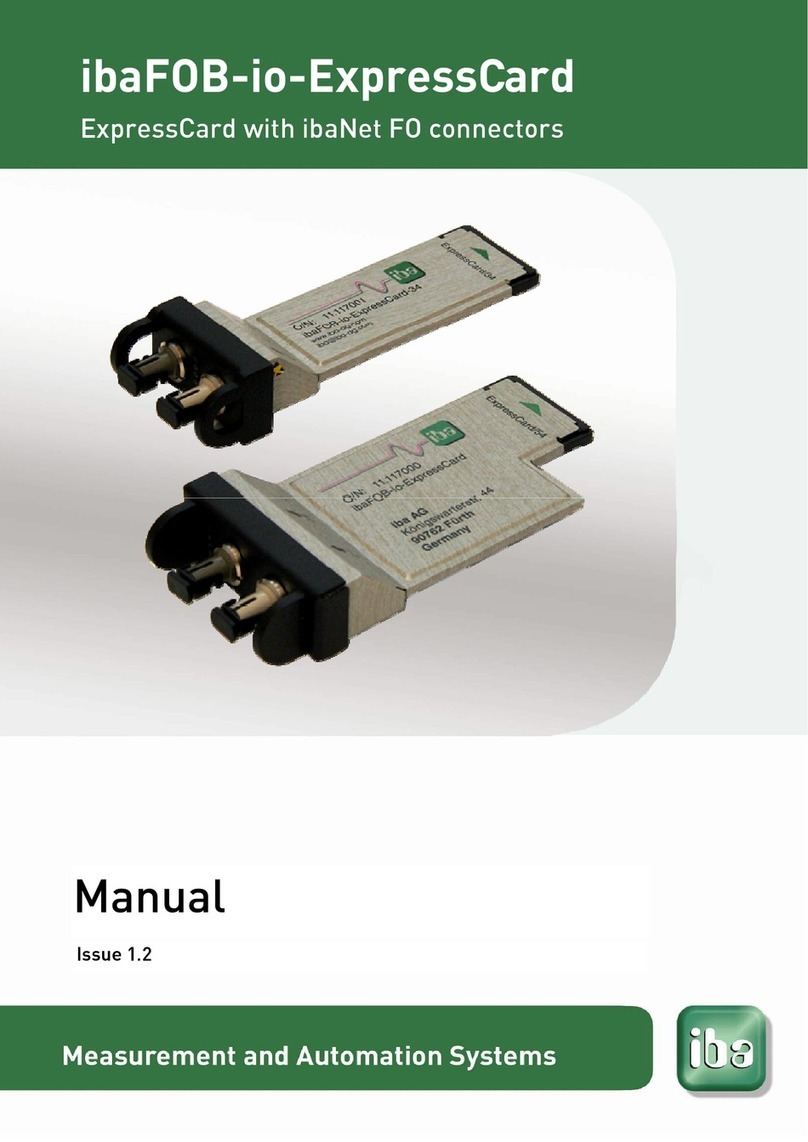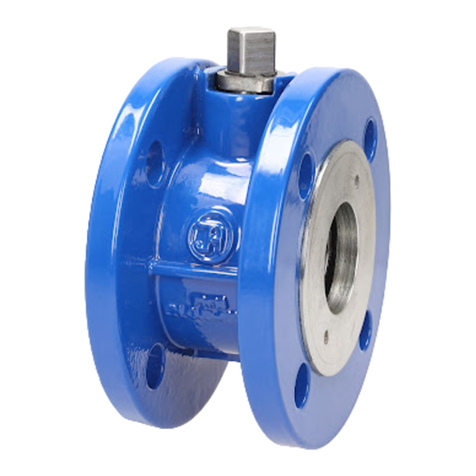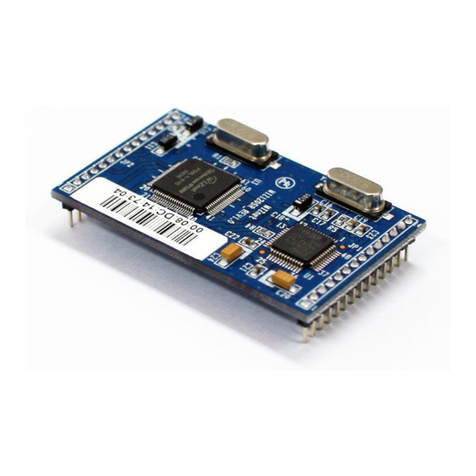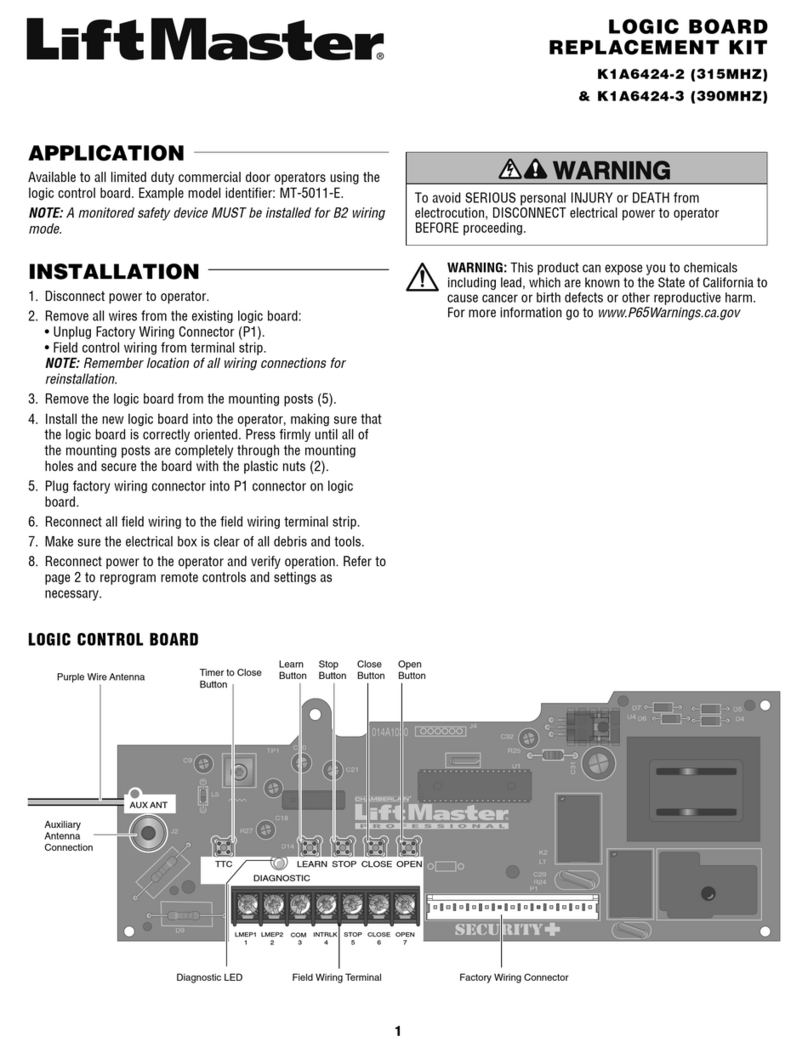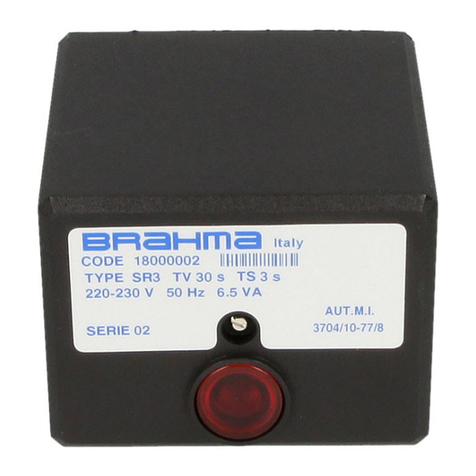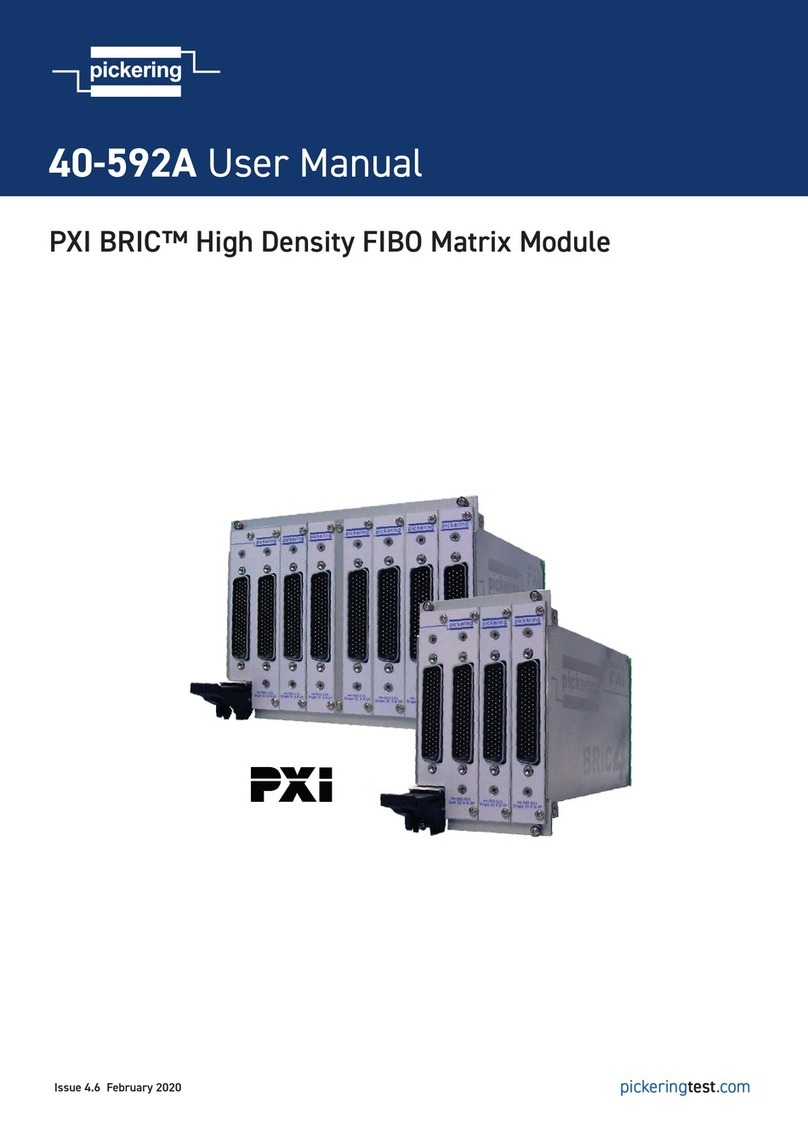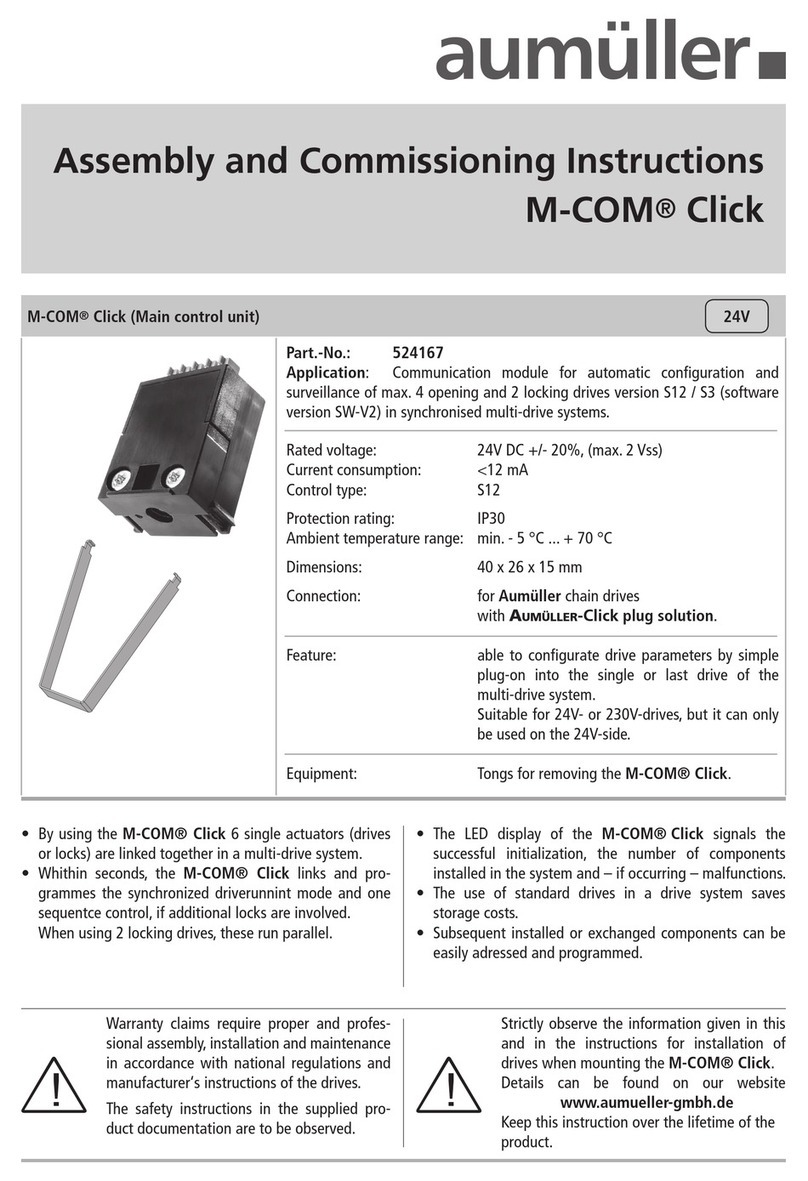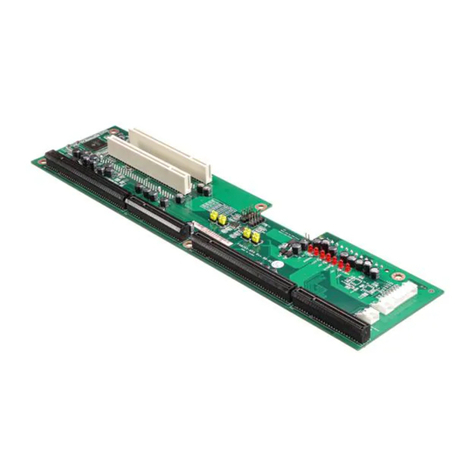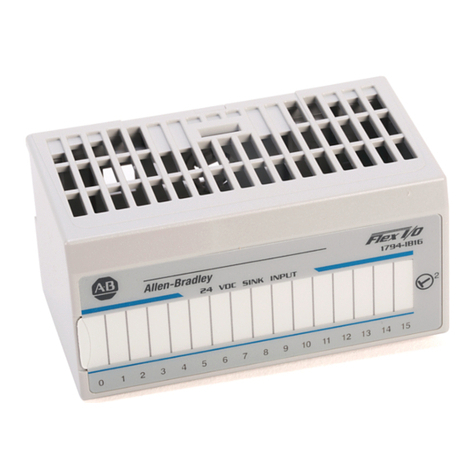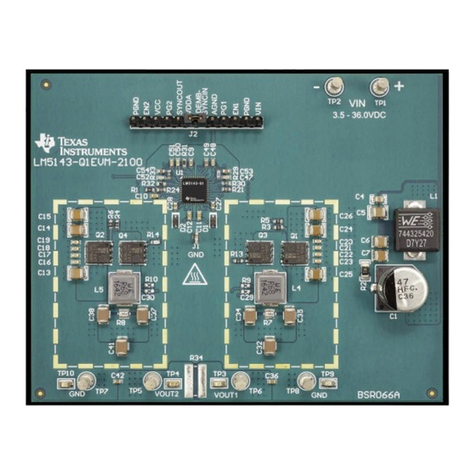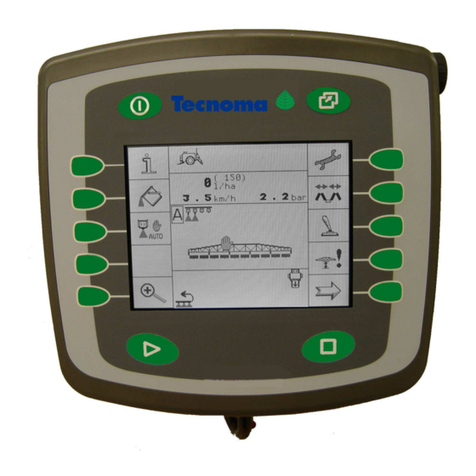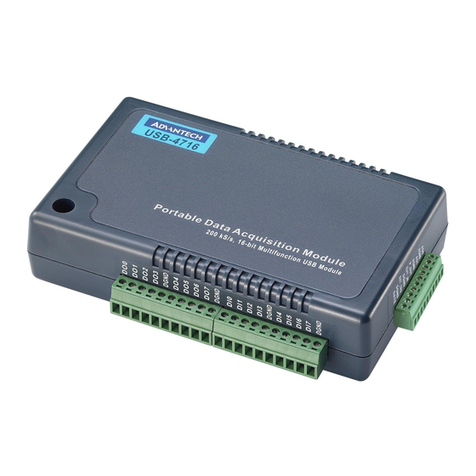TELECO AUTOMATION TVPLD868C80TT3 User manual

M
24Vdc /M
24Vdc
M
24Vdc
M
24Vdc
M
24Vdc
24Vdc
M
230Vac
230
Vac M
230Vac
M
230Vac
M
230Vac
230
Vac
24Vdc
24Vdc
M
230Vac /
230
Vac
M
230Vac
M
230Vac
IT - Codice prodotto FR - Code du produit EN - Product code DE - Artikelnummer
TVPLD868C80TT3 (868.3Mhz)
TVPLD916C80TT3 (916Mhz)
IT CENTRALE 230VAC CON RICEVITORE RADIO PER IL CONTROLLO DI UN MOTORE 24VDC PER PROFILI
ORIENTABILI ALIMENTATORE DA 80W INTEGRATO.
FR - CENTRALE 230VAC AVEC RÉCEPTEUR RADIO POUR LA COMMANDE DE 1 MOTEUR 24VDC POUR PROFILS
ORIENTABLES - BLOC D’ALIMENTATION INTÉGRÉ 80W.
EN 230VAC CONTROL UNIT WITH RADIO RECEIVER TO CONTROL ONE 24VDC MOTOR FOR ADJUSTABLE
SLATS 80W INTEGRATED POWER SUPPLY UNIT.
DE - 24VDC STEUEREINHEIT MIT FUNKEMPFÄNGER FÜR DIE STEUERUNG VON 1 GLEICHSTROM-MOTOR FÜR
VERSTELLBARE LAMELLEN. INTEGRIERTE 80W STROMVERSORGUNG.
M
24Vdc
IT - Auto-apprendimento necorsa e tempi lavoro.
FR - Auto-apprentissage des ns de course et temps de travail.
EN - Limit-switch and working time self-learning.
DE - Selbstlernen von Anschlag- und Betriebszeiten.
IT - Ingressi per sensori pioggia, vento,temperatura (per il ghiaccio).
Combinazione di sensori per rilevare la neve.
FR - Entrées pour capteurs de pluie, vent et température (pour le gel).
Combinaison de capteurs pour détecter la neige.
EN - Inputs for rain, wind and temperature (for ice) sensors.
Combination of rain and temperature sensors to detect snow.
DE - Eingänge für Regen- und Temperatursensor (für Eisgefahr) und
Windwächter. Sensoren-Kombination für Schneewarnung.
DOC.: T768.04
TVPLDXXXC80TT3 DATE: 24/02/20
TELECO AUTOMATION SRL
Via dell’Artigianato, 16 - 31014 Colle Umberto (TV) ITALY
TELEPHONE: +39.0438.388511 - www.telecoautomation.com
This document is the property of Teleco Automation Srl, which reserves all reproduction and copyrights

2
IT - INDICE FR - INDEX EN - INDEX DE - INHALT
IT
1. Collegamenti e regolazioni p. 3
2. TRASMETTITORI p. 4 - 6
2.1 Memorizzazione codici radio
2.2 Congurazione del tempo lavoro (necessaria
se si usano trasmettitori 7/42 canali)
2.3 Cancellazione codici radio
2.4 Memorizzazione remota di ulteriori codici radio
2.5 Cancellazione remota di un codice radio
3. SENSORI p. 6 - 7
3.1 Sensore VENTO
3.2 Sensore PIOGGIA
3.3 Condizione NEVE
3.4 Attivazione/Disattivazione sensore pioggia
3.5 Sensore TEMPERATURA
4. Speciche tecniche p. 20
FR
1. Branchements et réglages p. 3
2. ÉMETTEURS p. 8 - 10
2.1 Mémorisation des codes radio
2.2 Conguration du temps de travail (nécessaire
en cas d’utilisation d’émetteurs 7/42 canaux)
2.3 Suppression des codes radio
2.4 Mémorisation à distance d’autres codes radio
2.5 Suppression à distance d’un code radio
3. CAPTEURS p. 10 - 11
3.1 Capteur de VENT
3.2 Capteur de PLUIE
3.3 Sécurité neige
3.4 Activation/D§ésactivation du capteur de pluie
3.5 Capteur de température
4. Spécications techniques p. 20
EN
1. Connections and adjustments p. 3
2. TRANSMITTERS p. 12 - 14
2.1 Radio codes memorization
2.2 Working time conguration (necessary
if 7/42 channel transmitters are used)
2.3 Radio codes deletion
2.4 Remote memorization of other radio codes
2.5 Remote deletion of a radio code
3. SENSORS p. 14 - 15
3.1 WIND sensor
3.2 RAIN sensor
3.3 SNOW condition
3.4 Activation/Deactivation rain sensor
3.5 TEMPERATURE sensor
4. Technical specications p. 20
DE
1. Anschlüsse und Einstellungen S. 3
2. SENDER S. 16 - 18
2.1 Speicherung Funkcodes
2.2 Konguration der Betriebszeit (erforderlich bei
Verwendung von 7/42-Kanal-Sendern)
2.3 Löschung von Funkcodes
2.4 Fern-Speicherung weiterer Funkcodes
2.5 Fern-Löschung eines Funkcodes
3. WETTERSENSOREN S. 18 - 19
3.1 Windwächter
3.2 Regensensor
3.3 Schneefallbedingungen
3.4 Aktivierung/Deaktivierung des regen
3.5 Temperatursensor
4. Technische Daten S. 20
IT - AVVERTENZE FR - AVERTISSEMENTS EN - WARNINGS DE - WARNHINWEISE
IT - Il prodotto in oggetto deve essere installato, messo in servizio e controllato periodicamente solo da personale tecnico qualicato nel rispetto delle normative vigenti riguardanti le coperture automatiche. Tutti i collegamenti devono
essere previsti per un’alimentazione generale monofase 230Vac. Per la disconnessione dalla rete utilizzare un interruttore onnipolare con un’apertura dei contatti di almeno 3,5 mm. Predisporre tutti i dispositivi di sicurezza necessari ed utilizzare
materiali di collegamento idonei secondo le attuali normative sulla sicurezza elettrica. I cavi di collegamento devono avere una sezione adeguata al carico applicato. Prima di collegare l’alimentazione assicurarsi che i sensori e i motori siano
collegati correttamente. Un errato collegamento (polarità discordi) potrebbe danneggiare i motori oltre che gli elementi meccanici ad essi collegati. Si consiglia l’uso di un cavo 2x1.5mm per collegare i motori al dispositivo per una lunghezza
no a 6m, mentre è opportuno un cavo 2x2.5mm per tratte superiori. SMALTIMENTO DEL PRODOTTO: alla ne dalla vita utile, l’apparecchio non deve essere smaltito come riuto domestico, ma conferito in un centro di raccolta riuti elettrici
ed elettronici. Con la presente Teleco Automation s.r.l. dichiara che il prodotto è conforme ai requisiti essenziali, ed alle altre disposizioni pertinenti, stabilite dalla direttiva 1999/5/CE. La dichiarazione di conformità può essere consultata sul sito:
www.telecoautomation.com/ce. Nell’ottica di un continuo sviluppo dei propri prodotti, il produttore si riserva il diritto di apportare modiche a dati tecnici e prestazioni senza preavviso. FR - Le produit en objet doit être installé, mis en service et
vérié périodiquement seulement par des techniciens qualiés, conformément aux normes en vigueur pour les appareillages électriques. Tous les branchements doivent être prévus pour une alimentation générale en monophasé 230Vac.
Pour la déconnexion du réseau, utiliser un interrupteur omnipolaire avec une ouverture des contacts de minimum 3,5 mm. Installer tous les dispositifs de sécurité requis et utiliser des matériaux de branchement aptes à garantir une isolation
conforme aux normes de sécurité électrique. Les câbles de connexion doivent avoir une section adéquate à la charge appliquée. Avant la mise sous tension, s’assurer que les capteurs ainsi que le moteur sont raccordés de manière correcte.
Un mauvais branchement du ou des moteurs peut entrainer leur endommagement ainsi que celui de la structure. Pour le raccordement du ou des moteurs à la centrale, utiliser un câble de 2x1,5mm² jusqu’à 6m, au delà, utiliser un câble
2x2,5mm². ÉLIMINATION DU PRODUIT: à la n de la durée de vie utile de ce produit, il ne doit pas être éliminé comme tout autre déchet domestique. La Société Teleco Automation s.r.l. déclare que le produit est conforme aux conditions
essentielles, et aux autres dispositions applicables, établies par la directive 1999/5/CE. La déclaration de conformité peut être consultée sur le site internet www.telecoautomation.com/ce. Dans l’optique d’un développement continu de ses
produits, le constructeur se réserve le droit d’apporter sans préavis des modications aux données techniques et aux prestations. EN - The product at issue must be installed, commissioned and maintained only by licensed and authorised
people, respecting the laws concerning the automatic covers. All the connections must be rated for a single-phase 230Vac power supply. For the disconnection from the power line, use an all-pole switch with contacts having a dimension of at
least 3,5mm. Arrange all the necessary safety devices and use only materials complying with the standard of electrical installations. The cable must have a section properly rated according to the load connected. Before the connection to the
power supply make sure that the sensors and motors are correctly connected. A faulty connection of the motors (polarity inversion) could damage them together with the connected mechanical elements. Use a 2x1.5mm cable to connect the
motors and the control unit for length up to 6m, or 2x2.5mm cable for longer segments. PRODUCT DISPOSAL: at the end of this product’s useful life, it must not be disposed of as domestic waste, but must be taken to a collection centre for
waste electrical and electronic equipment. Hereby Teleco automation s.r.l. declares that the product complies with the essential requirements and other relevant provisions, established by the Directive 1999/5/EC. The declaration of conformity
can be consulted on the web site: www.telecoautomation.com/ce. In the view of a constant development of their products, the manufacturer reserves the right for changing technical data and features without prior notice.
DE - Das Produkt darf nur von qualiziertem technischen Personal unter Einhaltung der geltenden Gesetze installiert werden die automatische Abdeckungen betreen. Alle Verbindungen müssen auf einphasigen Wechselstrom mit 230 Volt
und dem jeweiligen Masseanschluss ausgelegt sein. Für die Abtrennung vom Netz ist ein allpoliger Schalter mit einer Kontaktönung von mindestens 3,5 mm zu verwenden. Für den Anschluss sind geeignete Materialien zu verwenden,
die eine Isolierung entsprechend den geltenden elektrischen Sicherheitsbestimmungen gewährleisten. Der Querschnitt der Verbindungskabel muss für die entsprechende Last geeignet dimensioniert sein. Vergewissern Sie sich vor dem
Anschließen des Geräts an das Stromnetz, dass die Sensoren und die Motoren korrekt verbunden sind. Bei einer falschen Verbindung (vertauschte Polarität) können die Motoren und die daran angeschlossenen mechanischen Teile beschädigt
werden. Für den Anschluss der Motoren an das Gerät bis zu einer Länge von 6 m wird ein 2x1.5mm Kabel empfohlen, während bei einer größeren Länge ein 2x2.5 mm Kabel empfohlen wird. ENTSORGUNG DES GERÄTS: nach dem
Ablauf der Nutzungszeit des Gerätes darf es nicht ohne Weiteres im Hausmüll entsorgt werden, sondern muss zu einer entsprechenden Entsorgungsstelle für elektronische Geräte gebracht werden. Hiermit erklärt Teleco Automation s.r.l.,
dass das Produkt den Anforderungen und den einschlägigen Bestimmungen der Richtlinie 1999/5/CE entspricht. Die Konformitätserklärung kann im Internet unter www.telecoautomation.com/ce eingesehen werden. Im Zuge
einer kontinuierlichen Weiterentwicklung der Produkte behält sich der Hersteller das Recht vor technische Daten und Funktionen ohne vorherige Ankündigung zu ändern.

3
IT-Collegamenti e regolazioni FR-Branchements et réglages
EN-Connections and adjustments DE-Anschlüsse und Einstellungen
IT - FINECORSA. La centrale è in grado di arrestare i motori in corrispondenza di un fermo meccanico, per
assorbimento di corrente. La soglia può essere impostata con DIP1 e DIP2 (tabella). Attenzione! Controllare
che il motore si fermi solo in corrispondenza dei necorsa (LM = ON): aumentare la soglia se il motore si ferma
durante la manovra o diminuire se il motore continua a spingere sui fermi meccanici. FR - FIN DE COURSE.
La centrale est en mesure d’arrêter les moteurs à la butée de n de course au travers de l’absorption de courant.
Le seuil est réglable au moyen des DIP1 et DIP2 (tableau). Attention! Contrôler que le moteur s’arrête bien aux
ns de course (LM = ON): augmenter le seuil si le moteur s’arrête pendant la manœuvre ou s’il continue à forcer
contre les butées mécaniques.
DIP1 DIP2 (A)
OFF OFF 1
OFF ON 2
ON OFF 3
ON ON 4
Default
EN - MOTOR STOPS. The control unit stops the motors at the point of a
mechanical stop through current absorption. The threshold can be set with DIP1
and DIP2 (table). Attention! Check that the motor only stops at the mechanical
stops (LM = ON): increase the threshold if the motor stops during operation or
decrease if the motor continues to push against the mechanical stops.
DE - ENDABSCHALTUNG. Das Steuergerät ist in der Lage, die Motoren bei
einer mechanischen Sperre durch Stromaufnahme anzuhalten. Die Schwelle
kann mit DIP1 und DIP2 eingestellt werden (Tabelle). Achtung! Kontrollieren,
dass der Motor wirklich bei dem Anschlag ausgeht (LM = ON): den Schwellenwert
erhöhen, wenn der Motor während des Manövers ausgeht. Den Schwellenwert
verringern, wenn der Motor bei Erreichen der mechanischen Sperren weiterläuft.
M
RN
LED
LR LA LM
8 9 10
DIP SWITCH P1
2
1
5
4
3
15
16
17
7
6
12
11
AN
LED
13
14
IT FR EN DE
1MOTORE (CHIUDE) MOTEUR (FERMETURE) MOTOR (CLOSE) MOTOR (ZU)
2MOTORE (APRE) MOTEUR (OUVERTURE) MOTOR (OPEN) MOTOR (AUF)
3SENSORE PIOGGIA (GIALLO, GND) CAPTEUR DE PLUIE (JAUNE, MASSE) RAIN SENSOR (YELLOW, GND) REGENSENSOR (GELB, GND)
4SENSORE PIOGGIA (BLU, SEGNALE) CAPTEUR DE PLUIE (BLEU, SIGNAL) RAIN SENSOR (BLUE, SIGNAL) REGENSENSOR (BLU, SIGNAL)
5SENSORE PIOGGIA (BIANCO, +12V) CAPTEUR DE PLUIE (BLANC,+12V) RAIN SENSOR (WHITE,+12V) REGENSENSOR (WEISS, +12V)
6SENSORE VENTO (BLU) ANÉMOMÈTRE (BLEU) WIND SENSOR (BLUE) WINDWÄCHTER (BLAU)
7SENSORE VENTO (MARRONE) ANÉMOMÈTRE (MARRON) WIND SENSOR (BROWN) WINDWÄCHTER (BRAUN)
8COMUNE INGRESSI COMMUN ENTRÉES INPUTS COMMON GEMEINSAMER ANSCHLUSS
9INGRESSO CHIUDE/STOP (N.A.) ENTRÉE FERMETURE/STOP (N.O) CLOSE/STOP INPUT (N.O.) EINGANG ZU/STOP (Schließer)
10 INGRESSO APRE/STOP (N.A.) ENTRÉE OUVERTURE/STOP (N.O) OPEN/STOP INPUT (N.O.) EINGANG AUF/STOP (Schließer)
11 ANTENNA RF ANTENNE RF AERIAL RF RF ANTENNE
12 ANTENNA GND MASSE ANTENNE AERIAL GND GND ANTENNE
15 ALIMENTAZIONE 230Vac (FASE) ALIMENTATION 230Vac (PHASE) 230Vac POWER SUPPLY (LIVE) 230Vac STROMVERSORGUNG (PHASE)
16 ALIMENTAZIONE 230Vac (NEUTRO) ALIMENTATION 230Vac (NEUTRE) 230Vac POWER SUPPLY (NEUTRAL) 230Vac STROMVERSORGUNG (NEUTRAL)
17 TERRA TERRE GROUND MASSE
AN LED IMPULSI SENSORE VENTO IMPULSIONS ANÉMOMÈTRE WIND SENSOR PULSES IMPULSE WINDWÄCHTER
RN LED SENSORE PIOGGIA ATTIVO CAPTEUR DE PLUIE DÉCLENCHÉ RAIN SENSOR ACTIVE REGEN SENSOR AUSGELÖST
LA LAMPEGGIANTE = ALLARME VENTO FEU CLIGNOTANT = ALARME VENT FLASHING = WIND ALARM BLINKEND= ALARM WIND
LR ACCESO = ALLARME PIOGGIA ALLUMÉ = ALARME PLUIE ON = RAIN ALARM AN= ALARM REGEN
LM LED FINECORSA LED FIN DE COURSE LIMIT SWITCH LED LED ENDSCHALTER
P1 TASTO DI PROGRAMMAZIONE BOUTON DE PROGRAMMATION PROGRAMMING BUTTON PROGRAMMIERUNGSTASTE
1

4
BCOMANDI AUTOMATICI (2 or 3 TASTI)
trasmettitore 7/42 channel
CH5
CH6
CH7
Open
STOP
Close
trasmettitore 3/18 canali
Apre
(STOP)
Chiude
(STOP)
trasmettitore 2 canali
CH1
CH2
CH3
CH4
CH5
CH6
CH7
Open (STOP)
Close (STOP)
Open (STOP)
Close (STOP)
Open
STOP
Close
A1 TASTO
CH1
CH2
CH3
CH4
CH5
CH6
CH7
0 % (CHIUSO)
50 %
70 %
100 % (APERTO)
Open (uomo presente)
STOP
Close (uomo presente)
2TRASMETTITORI
CHx
FunZIONI:
APRE-STOP-CHIUDE
oppure
CHIUDE
trasmettitore 7/42 canali
CTRASMETTITORE 7/42 CANALI
Premere il tasto P1 tante volte quante richieste dal tipo di memorizzazionedesiderata e tenere premuto. Il buzzer emette un suono continuo.
Premere il tasto del trasmettitore relativo al codice da memorizzare. All’avvenuta memorizzazione il buzzer emette un suono intermittente.
TIPO DI MEMORIZZAZIONE P1
A1 TASTO: *
1x
Premere il tasto del trasmettitore
relativo al codice da memorizzare.
BCOMANDI AUTOMATICI
(2 or 3 TASTI)
*
2x
A1 TASTO: *
3x
CTRASMETTITORE 7/42 CANALI *
4x
Premere un tasto qualsiasi del
trasmettitore 7/42 canali.
tenere
premuto
...
suono
continuo
APRE CHIUDE APRE
CHIUDE
suono intermittente
2.1 Memorizzazione codici radio
P1
*Il buzzer emmette un bip ad ogni pressione. Fra la pressione di un tasto e quella succesiva non deve passare più di un secondo.
IT

5
2.2 Congurazione del tempo lavoro (necessaria se si usano trasmettitori 7/42 canali)
Attenzione: la seguente procedura è indispensabile per poter utilizzare i trasmettitori a 7/42 canali (tipo C).
P1
*
x10
Comandare una
manovra con un
trasmettitore
memorizzato
oppure tramite
ingresso lare.
Premere nuovamente
P1 o attendere 25
secondi per uscire
dalla procedura senza
salvare.
Nota: è possibile interrompere questo ciclo automatico
con qualsiasi comando. Se viene superato il tempo lavoro
massimo (90 s) la centrale si ferma e suona in maniera
intermittente no alla pressione di un tasto qualsiasi.
(>3 s) suono intermittente
...
chiusura
completa
apertura
completa
...
LM lampeggia
apertura
completa
...
2.3 Cancellazione codici radio
TIPO DI
CANCELLAZIONE P1
SINGOLO CODICE RADIO *
x5
Premere un tasto relativo al codice da
cancellare.
Premere 5 volte il tasto P1 e tenere premuto. Il buzzer emette un suono continuo. Il buzzer emette un suono intermittente. Premere un
tasto del trasmettitore relativo al codice da cancellare entro 10 secondi. All’avvenuta cancellazione il buzzer emette un suono continuo.
TUTTI I CODICI RADIO *
x6
Premere 6 volte il tasto P1 e tenere premuto per 10 secondi. Il buzzer emette un suono intermittente veloce. Rilasciare quando il suono
diventa costante.
TENERE PREMUTO
(10 s)
suono
continuo
...
suono
intermittente
P1
IT
P1
Premere il tasto P1 10 volte e tenere premuto per 3 secondi.
Il buzzer emette un suono intermittente.
suono
continuo
...
*Il buzzer emmette un bip ad ogni pressione. Fra la pressione di un tasto e quella succesiva non deve passare più di un secondo.

6
3x
Cancellazione remota di un codice radio
Nota: Il tasto P3 si trova all’interno del trasmettitore. Il codice radio aggiunto avrà le stesse funzioni del
codice usato per l’inserimento. La procedura è compatibile con qualsiasi tipo di trasmettitore.
Premere per il tasto P3 del trasmettitore già memorizzato. Il buzzer emette un suono
continuo. Premere il tasto relativo ad un codice memorizzato. Il buzzer si ferma per
1 secondo e riprende il suono continuo. Premere il tasto relativo al nuovo codice.
All’avvenuta memorizzazione il buzzer emette un suono intermittente veloce.
...
P3
< 5 s
suono
intermittente
Da camcellare
1 s
...
P3
Nuovo
< 5 s
suono
continuo
Memorizzato
< 5 s
suono
continuo
Memorizzato Memorizzato
Nota: Il tasto P3 si trova all’interno del trasmettitore.
Premere 3 volte il tasto P3 del trasmettitore memorizzato. Il buzzer emette un
suono intermittente lento. Premere il tasto relativo al codice da cancellare entro 5
secondi. All’avvenuta cancellazione il buzzer smetterà di suonare.
2.4 2.5
Memorizzazione remota di ulteriori codici radio
Sensore VENTO
3.1
L’anemometro (ANEM4) rileva la velocità del vento e la centrale la confronta con la soglia impostata tramite i DIP 3-4 (vedi tabella).
La centrale è compatibile solamente con anemometri a 4 impulsi/giro.
ALLARME ATTIVO quando Cosa fa quando ALLARME ATTIVO ALLARME NON ATTIVO quando
La velocità rilevata è superiore
alla soglia impostata (vedi a anco).
La centrale orienta i proli della pergola al 50% dell’intera
apertura. LA lampeggia. La centrale non esegue alcun
comando.
Il sensore rileva per 30 secondi una
velocità inferiore alla soglia impostata.
DIP3 DIP4 Km/h
OFF OFF 40
OFF ON 50
ON OFF 60
ON ON 70
V
E
N
T
O
Priorità allarme
ALTA LA Lampeggia
IT
Condizioni di fabbrica
ATTIVATO

7
ALLARME ATTIVO quando Cosa fa quando ALLARME ATTIVO ALLARME NON ATTIVO quando
La supercie sensibile del sensore
rileva gocce d’acqua.
La centrale orienta i proli della pergola in completa CHIUSURA.
LR si accende. La centrale non esegue alcun comando.
Il sensore non rileva la pioggia.
Sensore PIOGGIA
3.2
P
I
O
G
G
I
A
LR ON Condizioni di fabbrica
ATTIVATO
Per poter gestire l’allarme associato alla condizione di neve è necessario siano attivi il sensore di temperatura (NTC 10K/3435K) ed il sensore pioggia.
Condizione NEVE
3.3
N
E
V
E
Condizioni di abbrica
DISATTIVATO
Attenzione: se il contatto della sonda di temperatura (13-14) è aperto (non collegato) e viene attivato l’allarme, l’unità di controllo inclina le lame della pergola al
66% dell’intera apertura con movimenti intermittenti.
LR Lampeggia
3.4 Attivazione/Disattivazione sensore PIOGGIA o condizione NEVE (pioggia+temperatura)
ALLARME PRESENTE quando Cosa fa quando ALLARME PRESENTE ALLARME NON PRESENTE quando
La temperatura misurata è al di sotto di 2°C
ed è stata rilevata pioggia.
La centrale orienta i proli della pergola al 66% dell’intera
apertura. La centrale esegue solo comandi a uomo presente.
La temperatura misurata è al di sopra di 3°C
oppure non viene più rilevata la pioggia.
STOP
(10 s)
suono
continuo
STOP
(10 s)
Disattivazione sensore (60 minuti)
Premere il pulsante “STOP” di un trasmettitore
memorizzato a 7/42 o 3 canali per 10 secondi.
Il buzzer emette 2 segnali acustici.
Attivazione sensore
Premere il pulsante “STOP” di un trasmettitore
memorizzato a 7/42 o 3 canali per 10 secondi.
Il buzzer emette un suono continuo.
Il sensore temperatura (NTC 10K/3435K) interviene qualora ci sia il pericolo di formazione di ghiaccio.
SENSORE TEMPERATURA
3.5
ALLARME PRESENTE quando Cosa fa quando ALLARME PRESENTE ALLARME NON PRESENTE quando
La temperatura misurata è al di sotto di 2°C La centrale orienta i proli della pergola al 10% La temperatura misurata è al di sopra di 3°C
e la pergola è chiusa. dell’intera apertura. o viene ricevuto un comando.
T
E
M
P
É
R
A
T
U
R
A
t°
IT

8
BCOMMANDES AUTOMATIQUES (2 ou 3 BOUTONS)
Émetteur 7/42 canaux
CH5
CH6
CH7
Ouverture
STOP
Fermeture
Émetteur 3/18 canaux
Ouverture
(STOP)
Fermeture
(STOP)
Émetteur 2 canaux
CH1
CH2
CH3
CH4
CH5
CH6
CH7
Ouverture (STOP)
Fermeture (STOP)
Ouverture (STOP)
Fermeture (STOP)
Ouverture
STOP
Fermeture
A1 BOUTON
CH1
CH2
CH3
CH4
CH5
CH6
CH7
0 % (FERMETURE)
50 %
70 %
100 % (OUVERTURE)
Ouverture (maintenue)
STOP
Fermeture (maintenue)
2ÉMETTEURS
CHx
Fonctions:
Ouverture-STOP-Fermeture
ou
Fermeture
Émetteur 7/42 canaux
CÉMETTEUR 7/42 CANAUX
Appuyer sur le bouton P1 le nombre de fois requis par le type de mémorisation et le maintenir appuyé. L’avertisseur sonore émet un son continu.
Appuyer sur le bouton de l’émetteur concernant le code à mémoriser. La mémorisation est conrmée par des bips rapides.
TYPE DE MÉMORISATION P1
A1 BOUTON: *
1x
Appuyer sur le bouton de l’émetteur
concernant le code à mémoriser.
BCOMMANDES AUTOMATIQUES
(2 ou 3 BOUTONS)
*
2x
A1 BOUTON: *
3x
CÉMETTEUR 7/42 CANAUX *
4x
Appuyer sur un quelconque bouton
de l’émetteur 7/42 canaux.
maintenue
...
Son
continu
son intermittent
2.1 Mémorisation des codes radio
P1
*L’avertisseur sonore émet un bip à chaque pression. Pas plus d’une seconde ne devrait s’écouler entre le fait d’appuyer sur une touche et la suivante.
FR
OUVRE STOP FERME
FERME

9
2.2 Conguration du temps de travail (nécessaire en cas d’utilisation d’émetteurs 7/42 canaux)
Attention : il est indispensable d’eectuer la procédure suivante pour pouvoir utiliser les émetteurs à 7/42 canaux (type C).
P1
*
10x
Lancer une
manœuvre au
moyen d’un
émetteur
mémorisé ou
d’une commande
laire.
Réappuyer sur P1 ou
attendre 25 secondes
pour quitter la procédure
sans sauvegarde.
Note: il est possible d’interrompre ce cycle automatique avec n’importe
quelle commande. Si le temps de travail maximal (90 s) est dépassé, la
centrale s’arrête en déclenchant un son intermittent qui dure jusqu’au
moment où l’on appuie sur un bouton quelconque.
(>3 s)
...
son intermittent
Fermeture
complète
Ouverture
complète
LM clignote
...
Ouverture
complète
...
FR
P1
Appuyer 10 fois de suite sur le bouton P1 et le maintenir appuyé
pendant 3 s. L’avertisseur sonore émet un son intermittent.
2.3 Suppression des codes radio
TYPE DE
SUPPRESSION P1
UN SEUL CODE RADIO *
5x
Appuyer sur un bouton de l’émetteur
concernant le code à supprimer.
Appuyer 5 fois de suite sur le bouton P1 et le maintenir appuyé. L’avertisseur sonore émet un son intermittent. Dans les 10 secondes
qui suivent, appuyer sur un bouton de l’émetteur concernant le code à supprimer. La suppression est conrmée par un son continu.
TOUS LES CODES RADIO *
6x
Appuyer 6 fois de suite sur le bouton P1 et le maintenir appuyé pendant 10 secondes. L’avertisseur sonore émet des bips rapides.
Lorsque l’avertisseur sonore émet un son continu, relâcher le bouton.
...
(10 s)
Son continu
...
son intermittent
P1
maintenue
*L’avertisseur sonore émet un bip à chaque pression. Pas plus d’une seconde ne devrait s’écouler entre le fait d’appuyer sur une touche et la suivante
Son continu

10
Suppression à distance d’un code radio
2.4 2.5
Mémorisation à distance d’autres codes radio
Capteur de VENT
3.1
L’anémomètre (ANEM4) détecte la vitesse du vent et la centrale la compare au seuil réglé au moyen des DIPS 3-4 (voir tableau).
La centrale est compatible seulement avec les anémomètres à 4 impulsions/tour.
L’ALARME SE DÉCLENCHE quand Que fait-il quand l’ALARME SE DÉCLENCHE L’ALARME NE SE DÉCLENCHE PAS quand
La vitesse détectée est supérieure
au seuil réglé (voir ci-contre).
La centrale intervient en faisant pivoter les lames de la
pergola à 50% de l’ouverture complète. LA clignote. La
centrale n’accepte aucune commande.
Le capteur détecte pendant 30 secondes
une vitesse inférieure au seuil réglé.
DIP3 DIP4 Km/h
OFF OFF 40
OFF ON 50
ON OFF 60
ON ON 70
V
E
N
T
Priorité alarme
HAUTE LA clignote
3x
Note : Le bouton P3 se trouve à l’intérieur de l’émetteur. Le code radio ajouté aura les mêmes fonctions que le
code utilisé pour la mémorisation. La procédure est compatible avec n’importe quel type d’émetteur.
Appuyer sur le bouton P3 de l’émetteur déjà mémorisé et le maintenir appuyé.
L’avertisseur sonore émet un son continu. Appuyer sur un bouton concernant un
code déjà mémorisé. L’avertisseur s’arrête un instant avant d’émettre de nouveau
un son continu. Appuyer sur le bouton concernant le code à mémoriser du nouvel
émetteur. La mémorisation est conrmée par des bips rapides.
...
P3
< 5 s
son intermittent
à supprimer
1 s
...
P3
Nouveau
< 5 s
Son
continu
Mémorisé
< 5 s
Son
continu
Mémorisé Mémorisé
Note : Le bouton P3 se trouve à l’intérieur de l’émetteur.
Appuyer trois fois de suite sur le bouton P3 de l’émetteur déjà mémorisé et le
maintenir appuyé. L’avertisseur émet des bips lents. Appuyer dans l’espace de 5
secondes sur le bouton concernant le code à supprimer. Dès que la suppression
a été eectuée, l’avertisseur sonore s’arrête de sonner.
Réglage d’usine
ACTIVÉ
FR

11
An de gérer ecacement la détection de neige, il est nécessaire de combiner les capteurs de température (NTC 10K/3435K) et de pluie.
Sécurité NEIGE
3.3
L’ALARME SE DÉCLENCHE quand Que fait-il quand l’ALARME SE DÉCLENCHE L’ALARME NE SE DÉCLENCHE PAS quand
La température relevée est sous 2°C et de
la pluie a été détectée.
La centrale intervient en faisant pivoter les lames de
la pergola à 66% de l’ouverture complète. La centrale
n’accepte aucune commande.
La température relevée est supérieure à 3°C ou il n’y a pas de détection
de pluie. Si l’on délivre une commande d’ouverture automatique au
moyen de l’émetteur la centrale sort de l’état d’alarme.
N
E
I
G
E
Réglage d’usine
DÉSACTIVÉ
Attention: si le contact de la sonde (13-14) devait rester ouvert (non connecté) et l’alarme se déclenche, la centrale pivote les lames de la pergola à 66% de
l’ouverture complète avec des mouvements intermittents.
LR clignote
Désactivation:
Appuyer pendant 10 s sur le bouton «STOP»
d’un émetteur mémorisé (7/42 ou 3 canaux).
L’avertisseur émet 2 bips. La procédure désactive
le capteur pendant 1 heure.
Activation:
Appuyer pendant 10 s sur le bouton «STOP»
d’un émetteur mémorisé (7/42 ou 3 canaux).
L’avertisseur sonore émet un son continu.
STOP
(10 s)
STOP
(10 s) Son continu
3.4 Activation/désactivation du capteur de PLUIE ou de PLUIE + TEMPERATURE (NEIGE)
Le capteur de température (NTC 10K/3435K) intervient en cas de risque de formation de glace. S’il n’est pas utilisé il faut connecter la borne 13
à la borne 14.
Capteur de TEMPÉRATURE
3.5
L’ALARME SE DÉCLENCHE quand Que fait-il quand l’ALARME SE DÉCLENCHE L’ALARME NE SE DÉCLENCHE PAS quand
La température relevée est sous 2°C . La centrale intervient en faisant pivoter les lames de la pergola à
10% de l’ouverture complète.
La température relevée est supérieure à 3°C
ou une nouvelle commande vient reçue.
T
E
M
P
É
R
A
T
U
R
E
t°
FR
L’ALARME SE DÉCLENCHE quand Que fait-il quand l’ALARME SE DÉCLENCHE L’ALARME NE SE DÉCLENCHE PAS quand
La surface sensible du capteur détecte
des gouttes d’eau.
La centrale intervient en faisant pivoter les lames de la pergola
jusqu’à la FERMETURE complète. LR allumé.
La centrale n’accepte aucune commande.
Le capteur ne détecte pas de pluie.
Capteur de PLUIE
3.2
P
L
U
I
E
LR allumé Réglage d’usine
ACTIVÉ

12
BAUTOMATIC COMMANDS (2 or 3 BUTTONS)
7/42 channel transmitter
CH5
CH6
CH7
Open
STOP
Close
3/18 channel transmitter
Open
(STOP)
Close
(STOP)
2 channel transmitter
CH1
CH2
CH3
CH4
CH5
CH6
CH7
Open (STOP)
Close (STOP)
Open (STOP)
Close (STOP)
Open
STOP
Close
A1 BUTTON
CH1
CH2
CH3
CH4
CH5
CH6
CH7
0 % (CLOSED)
50 %
70 %
100 % (OPEN)
Open (hold-to-run)
STOP
Close (hold-to-run)
2TRANSMITTERS
CHx
Functions:
OPEN-STOP-CLOSE
or
CLOSE
7/42 channel transmitter
C7/42 CHANNEL TRANSMITTER
Press the button P1 as many times as requested by the type of memorization and keep it pressed. The buzzer emits a continuous sound.
Press the button of the transmitter relative to the code to memorize. The memorization is indicated by an intermittent sound of the buzzer.
TYPE OF MEMORIZATION P1
A1 BUTTON: *
1x
Press the button of the transmitter
relative to the code to memorize.
BAUTOMATIC COMMANDS
(2 or 3 BUTTONS)
*
2x
A1 BUTTON: *
3x
C7/42 CHANNEL TRANSMITTER *
4x
Press any button of the 7/42 channel
transmitter.
keep it
pressed
...
continuous
sound
OPEN STOP CLOSE
CLOSE
intermittent sound
2.1 Radio codes memorization
P1
EN
*The buzzer will make a beep each press. No more than a second should pass between one press to another one.stopped.

13
2.2 Working time conguration (necessary if 7/42 channel transmitters are used)
Attention: the following procedure is necessary when using 7/42 channel transmitters (type C).
P1
*
10x
Command a
manoeuvre using
a memorized
transmitter or
by means of the
wired input.
Press P1 again or wait
25 seconds to quit
the procedure without
saving.
Note: this automatic cycle can be stopped with any
command. If working time is exceeded (90 s), the control
unit stops and emits an intermittent sound until any button
is pressed.
(>3 s)
...
intermittent sound
complete
closing
complete
opening
LM ashes
...
complete
opening
...
*The buzzer will make a beep each press. No more than a second should pass between one press to another one.stopped.
2.3 Radio codes deletion
TYPE OF DELETION P1
SINGLE RADIO CODE *
5x
Press the button of the transmitter
relative to the code to delete
Press 5 times the button P1 and keep it pressed. The buzzer emits an intermittent sound. Press the button of the transmitter relative to
the code to be deleted within 10 seconds. Successful deletion is indicated by a continuous sound of the buzzer.
ALL THE RADIO CODES *
6x
Press 6 times the button P1 and keep it pressed for 10 seconds. The buzzer emits a fast intermittent sound. Release when the sound
becomes continuous.
keep it pressed
...
(10 s)
continuous
sound
...
intermittent
sound
P1
EN
P1
Press the button P1 10 times and keep it pressed for 3 seconds.
The buzzer emits an intermittent sound.
continuous
sound

14
3x
Remote deletion of a radio code
Note: P3 button is located inside the transmitter. The added radio code will have the same functions of
the code used for the memorization. This procedure is compatible with any type of transmitter.
Press the button P3 of the memorized transmitter. The buzzer emits a
continuous sound. Press the button relative to a memorized code. The sound
stops for 1 second then it starts again. Press the button relative to the new
code. The memorization is indicated by an intermittent sound of the buzzer.
...
P3
< 5 s
intermittent
sound
To delete
1 s
...
P3
New
< 5 s
continuous
sound
Memorized
< 5 s
continuous
sound
Memorized Memorized
Note: P3 button is located inside the transmitter.
Press 3 times the button P3 of the memorized transmitter. The buzzer emits a
slow intermittent sound. Press the button relative to the code to delete within
5 seconds. The buzzer will stop sounding.
2.4 2.5
Remote memorization of further radio codes
WIND sensor
3.1
The anemometer (ANEM4) detects wind speed, which the control unit compares with the threshold set through DIPs 3-4 (see table).
The control unit is only compatible with anemometers generating 4 pulses per rev.
ACTIVE ALARM when Once ACTIVE ALARM DEACTIVATED ALARM when
The measured speed is higher then
the set threshold (see the table).
The control unit moves the louvres to the 50% of complete
opening and it doesn’t execute any command. LA ashes.
The sensor measures a speed lower than
the set threshold for at least 30 seconds.
DIP3 DIP4 Km/h
OFF OFF 40
OFF ON 50
ON OFF 60
ON ON 70
W
I
N
D
Alarm priority
HIGH LA ashes
EN
Factory setting
ACTIVATED

15
The temperature sensor (NTC 10K/3435K) activates whenever there is danger of ice forming.
TEMPERATURE sensor
3.5
ALARM ACTIVATED when What happens with ALARM ACTIVATED ALARM NOT ACTIVE when
The measured temperature is below 2 °C . The control unit tilts the pergola slats to 10% of full opening. The measured temperature is above 3 °C or
any command is received
T
E
M
P
É
R
A
T
U
R
E
t°
To manage the alarm associated with snow, the temperature (NTC 10K/3435K) and the rain sensors must be combined.
SNOW condition
3.3
S
N
O
W
Factory setting
DEACTIVATED
Warning: if the temperature probe contact (13-14) is open (not connected) and the alarm is triggered, the control unit tilts the slats of the pergola to 66% of the
full opening with intermittent movements.
LR ashes
3.4 Activation/deactivation RAIN sensor or SNOW condition (rain+temperature)
ALARM ACTIVATED when What happens with ALARM ACTIVATED ALARM NOT ACTIVE when
The measured temperature is below 2 °C and
rain has been detected.
The control unit tilts the slats to 66% of full opening. The control
unit only executes hold-to-run commands.
The measured temperature is above 3 °C or rain is
no longer detected. When the control unit receives a
command for automatic movement by transmitter, it
exits the alarm status.
STOP
(10 s)
continuous
sound
STOP
(10 s)
Sensor deactivation (60 minutes)
Press the “STOP” button of a memorized 7/42
or 3-channel transmitter for 10 s.
The buzzer emits 2 beeps.
Sensor activation
Press the “STOP” button of a memorized 7/42
or 3-channel transmitter for 10 s. The buzzer
emits a continuous sound.
ACTIVE ALARM when Once ACTIVE ALARM DEACTIVATED ALARM when
The sensitive surface of the sensor
detects any drops of water.
The control unit moves the louvres to the complete closing and
it doesn’t execute any command. LR is ON.
The sensor doesn’t detect any drop.
RAIN sensor
3.2
R
A
I
N
LR ON Factory setting
ACTIVATED

16
2.1
Die Taste P1 so oft drücken, wie bei der jeweiligen Speicherungsart gefordert ist und dann gedrückt halten. Der Summer erzeugt einen Dauerton. Die Taste des
Senders drücken, die dem zu speichernden Code entspricht. Der Summer bestätigt die erfolgreiche Speicherung durch einen schnellen intermittierenden Ton.
SPEICHERUNGSART P1
A1 TASTE: *
1x
Die Sendertaste drücken, die auf den
zu speichernden Code bezogen ist.
BAUTOMATISCHE BEFEHLE
(2 oder 3 Tasten)
*
2x
A1 TASTE: *
3x
C7/42-KANAL SENDER *
4x
Eine beliebige Taste des Senders mit
7/42 Kanälen drücken.
gedrückt
halten
Dauerton
intermittierender Ton
Speicherung Funkcodes
*Das Gerät quittiert jeden Druck mit einem Ton. Zwischen dem Drücken einer Taste und der nächsten darf nicht mehr als eine Sekunde vergehen.
DE
BAUTOMATISCHE BEFEHLE (2 oder 3 Tasten)
7/42-Kanal Sender
CH5
CH6
CH7
AUF
STOP
ZU
3/18-Kanal Sender
AUF
(STOP) ZU
(STOP)
2-Kanal Sender
CH1
CH2
CH3
CH4
CH5
CH6
CH7
A1 TASTE
CHx
C7/42-KANAL SENDER
7/42-Kanal Sender
CH1
CH2
CH3
CH4
CH5
CH6
CH7
0 % (ZU)
50 %
70 %
100 % (AUF)
AUF (manuelle)
STOP
ZU (manuelle)
AUF (STOP)
ZU (STOP)
AUF (STOP)
ZU (STOP)
AUF
STOP
ZU
Funktion:
AUF-STOP-ZU
oder
ZU
2SENDER
...
AUF STOP ZU
ZU
P1

17
2.3
2.2 Konguration der Betriebszeit (erforderlich bei Verwendung von 7/42-Kanal-Sendern)
Achtung: Die folgende Prozedur ist unerlässlich für die Verwendung von 7/42-Kanal-Sendern (Typ C).
P1
*
10x
Ein Manöver
mit einem
gespeicherten
Sender oder
Kabeleingang
durchführen.
Erneut P1 drücken
oder 25 S warten und
so die Prozedur ohne
Speicherung beenden.
Anmerkung: Es ist unmöglich, diesen automatischen Zyklus mit
irgendeinem Befehl zu beenden. Sollte die maximale Betriebszeit (90
S) überschritten werden, schaltet sich das Steuergerät ab und erzeugt
bis zum Drücken einer beliebigen Taste einen intermittierenden Ton.
(>3 S)intermittierender Ton
complete
closing
complete
opening
LM blinkt
complete
opening
DE
Zehnmal die Taste P1 drücken und beim zehnten Mal 3
Sekunden lang gedrückt halten. Der Summer gibt einen
intermittierenden Ton ab.
*Das Gerät quittiert jeden Druck mit einem Ton. Zwischen dem Drücken einer Taste und der nächsten darf nicht mehr als eine Sekunde vergehen.
Löschung von Funkcodes
ALLE FUNKCODES *
6x
Sechsmal die Taste P1 drücken und beim sechsten Mal 10 Sekunden lang gedrückt halten. Der Summer gibt einen schnell
intermittierenden Ton ab. Die Taste loslassen, wenn das Summen in einen Dauerton übergeht.
(10 s)
...
intermittierender Ton
LÖSCHUNGSART P1
EINZELNER FUNKCODE *
5x
Die Sendertaste drücken, die sich auf
den zu löschenden Code bezieht.
Fünfmal die Taste P1 drücken und gedrückt halten. Der Summer gibt einen Dauerton ab. Innerhalb von 10 Sekunden eine Taste des Senders drücken,
die dem zu löschenden Code zugeordnet ist. Die erfolgreiche Löschung wird vom Summer durch einen schnell intermittierenden Ton bestätigt.
gedrückt halten
Dauerton
Dauerton
...
...
P1
P1
... ...

18
3.1
2.4 2.5 Fern-Löschung eines Funkcodes
Fern-Speicherung weiterer Funkcodes
3x
Hinweis: Die Taste P3 befindet sich im Inneren des Senders. Der hinzugefügte Funkcode wird dieselben Funktionen
haben, wie der Code, der für die Eingabe verwendet wurde. Dieses Verfahren ist mit allenArten von Sendern kompatibel.
Die Taste P3 des bereits gespeicherten Senders drücken und gedrückt halten. Der Summer
erzeugt einen Dauerton. Eine Taste drücken, die mit einem bereits gespeicherten Code
assoziiert ist. Der Summer unterbricht sich für 1 Sekunde und gibt dann weiter seinen Dauerton
ab. Die Taste drücken, die mit dem zu speichernden Code des neuen Codes assoziiert ist. Die
erfolgreiche Speicherung wird vom Summer durch einen schnell intermittierenden Ton bestätigt.
...
P3
< 5 s
intermittierender
Ton
zu löschen
1 s
P3
Neu
< 5 s
Dauerton
gespeichert
< 5 s
Dauerton
gespeichert gespeichert
Hinweis: Die Taste P3 bendet sich im Inneren des Senders.
Dreimal die Taste P3 des bereits gespeicherten Senders drücken und gedrückt
halten. Der Summer erzeugt einen langsam intermittierenden Ton. Innerhalb
von 5 Sekunden eine auf den zu löschenden Code bezogene Taste drücken.
Bei erfolgter Löschung schaltet sich der Summer ab.
DIP1 DIP2 Km/h
OFF OFF 40
OFF ON 50
ON OFF 60
ON ON 70
WINDWÄCHTER Werkseinstellung
AKTIVIERT
LA BLINKT
W
I
N
D
Alarmprioriät
HOCH
Der Windwächter (ANEM4) ermittelt die Windgeschwindigkeit und das Steuergerät vergleicht den Wert mit der mittels DIP 3-4
vorgegebenen Schwelle (s. Tabelle). Das Steuergerät ist nur kompatibel mit Windmessern mit 4 Impulsen/Umdrehung.
ALARM AUSGELÖST, wenn Was macht er bei ALARM AUSGELÖST ALARM NICHT AUSGELÖST wenn
Die gemeldete Windgeschwindigkeit
ist höher als die eingestellte Schwelle
(s. nebenstehende Abb.)
Das Steuergerät stellt die Lamellen der Pergola
auf 50% der Vollönung ein. Das Steuergerät führt
keinerlei Befehl aus.
Der Sensor misst über 30 Sekunden
eine Geschwindigkeit unterhalb der
eingestellten Schwelle.
...

19
3.5
3.4
3.3
3.2 REGENSENSOR Werkseinstellung
AKTIVIERT
R
E
G
E
N
LR EIN
ALARM AUSGELÖST, wenn Was macht er bei ALARM AUSGELÖST ALARM NICHT AUSGELÖST wenn
Die Benetzung des Sensors durch
Regentropfen wird erfasst.
Das Steuergerät stellt die Lamellen der Pergola auf VOLLSCHLIESSUNG
ein. Das Steuergerät führt keinerlei Befehl aus. LR = EIN.Der Sensor erfasst keinen Regen.
Um den Schneefall-Alarm verwalten zu können, müssen Temperatursensor und Regensensor aktiviert werden.
SCHNEEFALLBEDINGUNGEN Werkseinstellung
DEAKTIVIERT
ALARM AUSGELÖST, wenn Was macht er bei ALARM AUSGELÖST ALARM NICHT AUSGELÖST wenn
Die gemessene Temperatur liegt unter 2 °C
und Regen wurde ermittelt.
Das Steuergerät stellt die Lamellen der Pergola auf 66% der
Vollönung ein. Das Steuergerät führt nur manuelle Befehle aus.
Die gemessene Temperatur liegt oberhalb von
3 °C und es wird kein Regen mehr ermittelt.
S
C
H
N
E
E
F
A
L
L
LR BLINKT
Der Temperatursensor (NTC 10K/3435K) greift ein, wenn die Gefahr der Eisbildung besteht.
TEMPERATURSENSOR
T
E
M
P
E
R
A
T
U
R
t°
ALARM AUSGELÖST, wenn Was macht er bei ALARM AUSGELÖST ALARM NICHT AUSGELÖST wenn
Die gemessene Temperatur liegt unter 2 °C
und die Pergola ist geschlossen.
Das Steuergerät stellt die Lamellen der Pergola auf 10% der
Vollönung ein.
Die gemessene Temperatur liegt oberhalb
von 3°C oder das Steuergerät empfängt einen
Befehl.
ALARM AUSGELÖST, wenn Was macht er bei ALARM AUSGELÖST ALARM NICHT AUSGELÖST wenn
Die Benetzung des Sensors durch
Regentropfen wird erfasst.
Das Steuergerät stellt die Lamellen der Pergola auf VOLLSCHLIESSUNG
ein. Das Steuergerät führt keinerlei Befehl aus. LR = EIN.Der Sensor erfasst keinen Regen.
Deaktivierung der Sensor (60 Minuten)
10Sek. lang die “STOP”-Taste eines gespeicherten
Senders drücken (7/42 o 3 Kanäle).
Der Summer erzeugt 2 kurze Töne.
Aktivierung der Sensors
10Sek.lang die “STOP”-Taste eines gespeicherten
Senders drücken (7/42 o 3 Kanäle). Der Summer
erzeugt einen Dauerton.
AKTIVIERUNG/DEAKTIVIERUNG DES REGEN/SCHEEFALLSENSORS (REGEN+TEMP.)
STOP
(10 s)
Dauerton
STOP
(10 s)

4
Alimentazione - Alimentation - Power supply - Stromversorgung 230Vac
Potenza alimentatore - Puissance bloc d’alimentation
- Power supply unit - Netzteil 80W
Potenza massima uscita - Puissance maximale de sortie
- Max. output power - Max. Ausgänge Leistung max. 3A (24Vdc)
Alimentazione sensore pioggia - Alimentation du capteur de pluie
- Rain sensor power supply - Stromversorgung des Regensensor 12 Vdc (max.100mA)
Temperatura di funzionamento - Température de fonctionnement
- Operating temperature range - Umgebungstemperatur im Betrieb -20° - +50°C
Tempo lavoro - Temps de travail - Working time - Betriebszeit 90 s
Grado di protezione - Degré de protection - Protection rating - Schutzart IP54
Frequenza ricezione - Fréquence de réception
- Reception frequency - Empfangsfrequenz
868.3 MHz (TVPLD868C80TT3)
916 MHz (TVPLD916C80TT3)
Capacità memoria radio (trasmettitori) - Capacité mémoire radio (émetteurs) -
Radio memory capability (transmitters) -Speicherbare Sender 16
185 mm
70 mm
56 mm
18 mm
Non adatto all’esposizione diretta ai raggi UV
Pas d’exposition directe aux UV
Not suitable for direct UV exposure
Nicht für direkte UV-Exposition geeignet
Thermoplastic ABS
IT - Per prevenire le inltrazioni d’acqua,
collegare il prodotto come segue:
FR - Pour éviter les inltrations d’eau, il
est conseillé de câbler le produit comme
indiqué ci-dessous:
EN - To prevent inltration of water, wire the
product as follows:
DE - Schließen Sie das Produkt wie folgt
an, um ein Eindringen von Wasser zu
verhindern:
56 mm
151 mm
IT - Speciche Tecniche FR - Spécications techniques
EN - Technical specications DE-Technische Daten
TELECO AUTOMATION S.R.L.
ITALY
Tel. +39.0438.388511
info@telecoautomation.com
TELECO AUTOMATION FRANCE
FRANCE
Tel. +33.(0)472.145080
info@telecofrance.com
TELECO AUTOMATION GMBH
GERMANY
Tel. +49.(0)8122.9563024
info.de@telecoautomation.com
TELECO AUTOMATION OCEANIA PTY LTD
AUSTRALIA
Tel. +61.(07)5502.7801
info@telecoautomation.com.au
This document is the property of Teleco Automation Srl, which reserves all reproduction and copyrights
TELECO AUTOMATION BENELUX SPRL
BELGIUM
Tel. +32.(0)67561967
info@telecoautomation.be
Fori di ssaggio del prodotto
Product fastening holes
Trous de xation du produit
Befestigungslöcher des Produkts
This manual suits for next models
1
Table of contents
Languages:
Other TELECO AUTOMATION Control Unit manuals
